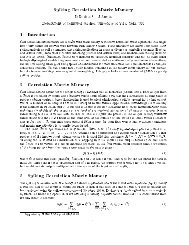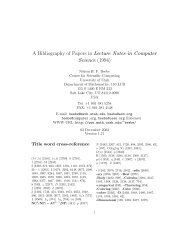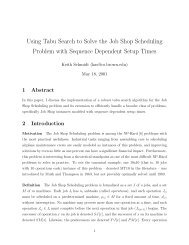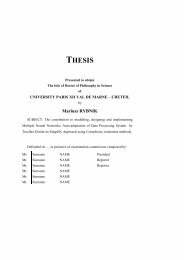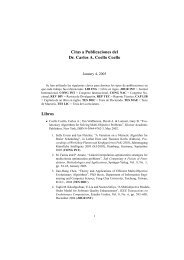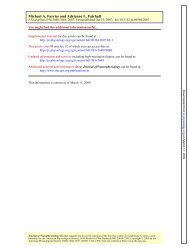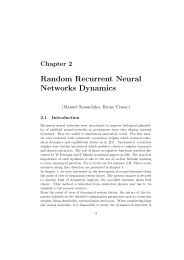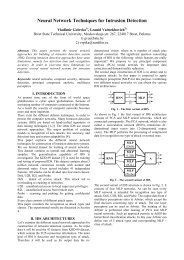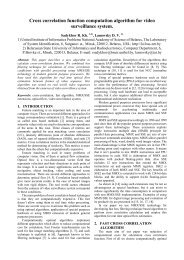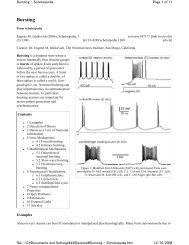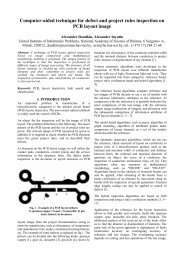Path Planning for Mobile Robot Navigation using Voronoi - BSTU ...
Path Planning for Mobile Robot Navigation using Voronoi - BSTU ...
Path Planning for Mobile Robot Navigation using Voronoi - BSTU ...
You also want an ePaper? Increase the reach of your titles
YUMPU automatically turns print PDFs into web optimized ePapers that Google loves.
<strong>Path</strong> <strong>Planning</strong> <strong>for</strong> <strong>Mobile</strong> <strong>Robot</strong> <strong>Navigation</strong> <strong>using</strong><br />
<strong>Voronoi</strong> Diagram and Fast Marching<br />
Santiago Garrido<br />
<strong>Robot</strong>ics Lab.<br />
Carlos III University<br />
Madrid, Spain<br />
Email: sgarrido@ing.uc3m.es<br />
Luis Moreno<br />
<strong>Robot</strong>ics Lab.<br />
Carlos III University<br />
Madrid, Spain<br />
Email: moreno@ing.uc3m.es<br />
Abstract— This paper presents a new sensor based global<br />
<strong>Path</strong> Planner which operates in two steps. In the first step the<br />
safest areas in the environment are extracted by means of a<br />
<strong>Voronoi</strong> diagram. In the second step Fast Marching Method is<br />
applied to the <strong>Voronoi</strong> extracted areas in order to obtain the<br />
shortest path. In this way the trajectory obtained is the shortest<br />
between the safe possible ones. This two step method combines an<br />
extremely fast global planner operating on a simple sensor based<br />
environment modeling, while it operates at the sensor frequency.<br />
The main characteristics are speed and reliability, because the<br />
map dimensions are reduced to a unidimensional map and this<br />
map represents the safest areas in the environment <strong>for</strong> moving<br />
the robot.<br />
I. INTRODUCTION<br />
<strong>Robot</strong> motion planing problems have been an important<br />
research topic since the 80’s. A considerable number of<br />
researchers have been working extensively to develop efficient<br />
methods to overcome these problems. This issue has been dealt<br />
with in two general ways: one approach was concentrated in<br />
solving motion planing problems <strong>using</strong> a previously known<br />
global environment or obstacle in<strong>for</strong>mation and the robot<br />
characteristics, while the second approach has concentrated in<br />
planing motion <strong>using</strong> local sensor in<strong>for</strong>mation and the robot<br />
characteristics.<br />
When we want to move a robot from one location to<br />
another it is necessary to use a global map to calculate a<br />
global trajectory. <strong>Mobile</strong> robot path planning approaches can<br />
be divided into five classes [1]. Roadmap methods extract<br />
a network representation of the environment and then apply<br />
graph search algorithms to find a path. Exact cell decomposition<br />
methods construct non-overlapping regions that cover free<br />
space and encode cell connectivity in a graph. Approximate<br />
cell decomposition is similar, but cells are of predefined shape<br />
(e.g. rectangles) and do not exactly cover free space. Potential<br />
field methods differ from the other four in that they consider<br />
the robot as a point evolving under the influence of <strong>for</strong>ces<br />
that attract it to the goal while pushing it from obstacles.<br />
<strong>Navigation</strong> functions are commonly considered a special case<br />
of potential fields.<br />
In order to calculate the trajectory in the global map,<br />
this paper presents a new <strong>Path</strong> <strong>Planning</strong> method based in<br />
1 Acknowledge the funding from the Spanish Ministry of Science and<br />
Technology within the ’Ramón y Cajal’ program.<br />
Mohamed Abderrahim 1<br />
<strong>Robot</strong>ics Lab.<br />
Carlos III University<br />
Madrid, Spain<br />
Email: mohamed@ing.uc3m.es<br />
Fernando Martin<br />
<strong>Robot</strong>ics Lab.<br />
Carlos III University<br />
Madrid, Spain<br />
Email: fmartin@ing.uc3m.es<br />
the combination of <strong>Voronoi</strong> Diagram and the Fast Marching<br />
Method.<br />
The Fast Marching Method has been applied to <strong>Path</strong> <strong>Planning</strong><br />
[Sethian:1], and their trajectories are of minimal distance,<br />
but they are not very safe because the path is too close to<br />
obstacles resulting in jerky trajectories.<br />
In order to improve the safety of the trajectories calculated<br />
by the Fast Marching Method, it is possible to give two<br />
solutions:<br />
The first possibility, in order to avoid unrealistic trajectories,<br />
produced when the areas are narrower than the robot, the<br />
segments with distances to the obstacles and walls less than<br />
half the size of the robot need to be removed from the <strong>Voronoi</strong><br />
Diagram.<br />
The second possibility, used in this work, is to dilate the<br />
objects and walls in a security distance that ensures that the<br />
robot neither collides with obstacles and walls nor accepts<br />
passages narrower than the robot size.<br />
The last step is to calculate the trajectory in the image<br />
generated by the <strong>Voronoi</strong> Diagram <strong>using</strong> the Fast Marching<br />
Method. Then, the obtained path verifies the smooth and safety<br />
considerations required <strong>for</strong> mobile robot path planning.<br />
The advantages of this method are the easy implementation,<br />
the speed of the method and the quality of the trajectories. The<br />
method works in 2D and 3D, and it can be used at a global<br />
or local scale, in this case operating with sensor in<strong>for</strong>mation<br />
instead of <strong>using</strong> an a priori map (sensor based planning).<br />
II. INTRODUCTION TO THE VORONOI DIAGRAM AND<br />
SKELETON<br />
It has been observed that the skeleton is embedded in<br />
the <strong>Voronoi</strong> diagram of a polygonal shape [2]. Similarly,<br />
the skeleton of a shape described by a discrete sequence<br />
of boundary points can be approximated from the <strong>Voronoi</strong><br />
diagram of the points [3]. Both approaches yield a connected,<br />
Euclidean skeleton, but the latter is perhaps more appropriate<br />
<strong>for</strong> images since point sequences are more easily obtained<br />
than polygons. Although it is not true in general, if one<br />
restricts the shapes to those which are morphologically open<br />
and closed with respect to a finite-sized disk, the resulting<br />
skeleton approximated from the <strong>Voronoi</strong> diagram of a finite<br />
sampling of the boundary is close to the actual skeleton. In
this case, the approximation error can be quantified, and be<br />
made arbitrarily close to zero.<br />
A. <strong>Voronoi</strong> Diagram and Skeleton.<br />
Consider the set F , closed in R 2 . Associated with each point<br />
in F is its <strong>Voronoi</strong> region.<br />
VF (p) = {q : d(q, p) ≤ d(q, F/{p})} (1)<br />
The <strong>Voronoi</strong> diagram of F is the union of the boundaries<br />
of all the <strong>Voronoi</strong> regions.<br />
V D(F ) = <br />
∂VF (p). (2)<br />
p∈F<br />
A maximal disk in G is one which is contained in G while<br />
not being contained by any other disk in G. Assume that all<br />
maximal disks in G are bounded. The skeleton σ(G) is the set<br />
of centers of maximal disks in G. One desires the skeleton to<br />
be a ”graph-like” retraction of the original set. In general, this<br />
cannot be assured due to the presence of infinitesimal detail.<br />
However, it is possible to eliminate these fine structures by<br />
assuming a reasonable subclass: the regular sets.<br />
A compact set, K, is said to be r − regular [4] if it is<br />
morphologically open and closed with respect to a disk of<br />
radius r > 0. It is possible to show that ∂K is a disjoint<br />
union of closed simple C 2 curves with curvature magnitude<br />
no greater than 1/r . The skeleton of the interior of K is<br />
well-behaved and graph-like.<br />
B. Skeleton-based generalization algorithm<br />
One issue that needs improvement is the existence of<br />
spurious hairs on the skeletons generated. This is a well-known<br />
artifact of skeleton generation, where any irregularities in the<br />
boundary generate unwanted skeleton branches. Ogniewicz [?]<br />
attempted to reduce skeletons <strong>for</strong>med from raster boundary<br />
points to a simple <strong>for</strong>m by pruning the leaf nodes of the<br />
skeleton until a specified minimum circumcircle was achieved,<br />
but with the development of the one-step crust and skeleton<br />
algorithm this process may be greatly simplified. Alt and<br />
Schwartzkopf [5], as well as Blum [6] showed that leaf nodes<br />
of a skeleton correspond to locations of minimum curvature on<br />
the boundary. For a sampled boundary curve this means that<br />
three adjacent sample points are cocircular, with their centre at<br />
the skeleton leaf. If we wish to simplify the skeleton we should<br />
retract leaf nodes to their parent node location. This means<br />
that we now have four cocircular points instead of three. The<br />
retraction is per<strong>for</strong>med by taking the central point of the three<br />
defining the leaf node, and moving it towards the parent node<br />
of the skeleton until it meets the parent node circumcircle.<br />
This smooths outward-pointing salients in the boundary of<br />
the object. The same should be done from the other side of<br />
the boundary, retracting those salients also. This may displace<br />
some of the points involved in the first smoothing step, but as<br />
the process is convergent a small number of iterations suffices<br />
to produce a smoothed curve having the same number of points<br />
as the original, but with a simplified skeleton.<br />
III. INTRODUCTION TO THE LEVEL SET METHOD AND<br />
THE FAST MARCHING METHOD<br />
The level set method was devised by Osher and Sethian as<br />
a simple and versatile method <strong>for</strong> computing and analyzing<br />
the motion of the interface in two or three dimensions. The<br />
goal is to compute and analyze the subsequent motion of the<br />
interface under a velocity field. This velocity can depend on<br />
position, time, the geometry of the interface and the external<br />
physics. The interface is captured <strong>for</strong> later time as the zero<br />
level set of a smooth (at least Lipschitz continuous) function.<br />
Topological merging and breaking are well defined and easily<br />
per<strong>for</strong>med.<br />
The original level set idea of Osher and Sethian (Osher [7])<br />
<strong>for</strong> tracking the evolution of an initial front γ0 as it propagates<br />
in a direction normal to itself with a given speed function V .<br />
The main idea is to match the one-parameter family of fronts<br />
{γt} t≥0 , where γt, is the position of the front at time t, with<br />
a one-parameter family of moving surfaces in such a way that<br />
the zero level set of the surface always yields the moving<br />
front. To determine the front propagation, we then need to<br />
find and solve a partial differential equation <strong>for</strong> the motion of<br />
the evolving surface. To be more precise, let γ0 be an initial<br />
front in R d , d ≥ 2 and assume that the so-called level set<br />
function φ : R d × R+ → R is such that at time t ≥ 0 the<br />
zero level set of φ is the front γt. We further assume that<br />
φ(x; 0) = ±d(x); where d(x) is the distance from x to the<br />
curve γ0. We use plus sign if x is inside 0 and minus if x is<br />
outside. Let each level set of φ along its gradient field with<br />
speed V . This speed function should match the desired speed<br />
function <strong>for</strong> the zero level set of φ. Now consider the motion<br />
of, e.g., the level set<br />
x ∈ R d : φ(x; t) = 0 . (3)<br />
Let x(t) be trajectory of a particle located at this level set<br />
so that<br />
φ(x(t); t) = 0. (4)<br />
The particle speed dx/dt in the direction n normal to the<br />
level set is given by the speed function V , and hence<br />
dx<br />
dt<br />
where the normal vector n is given by<br />
· n = V. (5)<br />
n = − ∇φ<br />
. (6)<br />
|∇φ|<br />
This is a vector pointing outwards, giving our initialization<br />
of u. By the chain rule<br />
∂φ<br />
∂t<br />
+ dx<br />
dt<br />
· ∇φ = 0. (7)<br />
There<strong>for</strong>e φ(x; t) satisfies the partial differential equation<br />
(the level set equation)
∂φ<br />
− V |∇φ| = 0, (8)<br />
∂t<br />
and the initial condition<br />
φ(x; t = 0) = ±d(x). (9)<br />
This is called an Eulerian <strong>for</strong>mulation of the front propagation<br />
problem because it is written in terms of a fixed coordinate<br />
system in the physical domain.<br />
If the speed function V is either always positive or always<br />
negative, we can introduce a new variable (the arrival time<br />
function) T (x) defined by<br />
dx<br />
dt<br />
φ(x, T (x)) = 0. (10)<br />
In other words, T (x) is the time when φ(x; t) = 0. If<br />
= 0, then T will satisfy the stationary Eikonal equation<br />
coupled with the boundary condition<br />
V |∇T | = 1, (11)<br />
T | d(x)=0 = 0. (12)<br />
The advantage of this <strong>for</strong>mulation 11 is that we can solve<br />
it numerically by the fast marching method [8], which is<br />
precisely what we will do in this paper.<br />
Fig. 1. Map of the room used in the first experiment with its <strong>Voronoi</strong><br />
Diagram.<br />
Summing up, the central mathematical idea is to view the<br />
moving front γt as the zero level set of the higher-dimensional<br />
level set function φ(x; t). Depending on the <strong>for</strong>m of the speed<br />
function V , the propagation of the level set function φ(x; t)<br />
is described by the initial problem <strong>for</strong> a nonlinear Hamilton-<br />
Jacobi type partial differential equation 7 of first or second<br />
order.<br />
If V > 0 or V < 0, it is also possible <strong>for</strong>mulate the problem<br />
in terms of a time function T (x) which solves a boundary<br />
value problem <strong>for</strong> a stationary Eikonal equation 11.<br />
Fast Marching Methods are designed <strong>for</strong> problems in which<br />
the speed function never changes sign, so that the front<br />
Fig. 2. Enlarged <strong>Voronoi</strong> Diagram of the room.<br />
Fig. 3. Inverted image of the Enlarged <strong>Voronoi</strong> Diagram of the room.<br />
Fig. 4. Trajectory calculated by Fast Marching Method in the inverted image<br />
of the Enlarged <strong>Voronoi</strong> Diagram of the room.
is always moving <strong>for</strong>ward or backward. This allows us to<br />
convert the problem to a stationary <strong>for</strong>mulation, because the<br />
front crosses each grid point only once. This conversion to a<br />
stationary <strong>for</strong>mulation, plus a whole bunch of numerical tricks,<br />
gives it its tremendous speed<br />
Level Set Methods are designed <strong>for</strong> problems in which the<br />
speed function can be positive in some places are negative in<br />
others, so that the front can move <strong>for</strong>wards in some places<br />
and backwards in others. While significantly slower than Fast<br />
Marching Methods, embedding the problem in one higher<br />
dimension gives the method tremendous generality.<br />
Because of the nonlinear nature of the governing partial<br />
differential equation 7 or 11, solutions are not smooth enough<br />
to satisfy this equation in the classical sense (the level set<br />
function and the time function are typically only Lipschitz).<br />
Furthermore, generalized solutions, i.e., Lipschitz continuous<br />
functions satisfying the equations almost everywhere, are not<br />
uniquely determined by their data and additional selection<br />
criteria (entropy conditions) are needed to pick out the (physically)<br />
correct generalized solutions. The correct mathematical<br />
framework in which to treat Hamilton-Jacobi type equations<br />
is provided by the notion of viscosity solutions (Crandall [9],<br />
[10]).<br />
After its introduction, the level set approach has been<br />
successfully applied to a wide collection of problems that<br />
arise in geometry, mechanics, computer vision, and manufacturing<br />
processes, see ( Sethian [11]) <strong>for</strong> details. Numerous<br />
advances have been made to the original technique, including<br />
the adaptive narrow band methodology ( Adalsteinsson and<br />
Sethian [12]) and the fast marching method <strong>for</strong> solving the<br />
static Eikonal equation ( Sethian [13], [11]). For further details<br />
and summaries of level set and fast marching techniques <strong>for</strong><br />
numerical purposes, see ( Sethian [11]). The Fast Marching<br />
Method is an O(n log(n)) algorithm.<br />
IV. IMPLEMENTATION OF THE METHOD<br />
This method operates in two steps. The first step starts with<br />
the calculation of the <strong>Voronoi</strong> Diagram of the 2D or 3D a<br />
priori map of the environment (which are the cells located<br />
equidistant to the obstacles). This process is done by means<br />
of morphological operations on the image of the environment<br />
map. To be more precise, it is done a skeletonization with<br />
the image techniques previously mentioned, in order to obtain<br />
the <strong>Voronoi</strong> Diagram. After that, a dilatation is done in order<br />
to have a thick <strong>Voronoi</strong> Diagram where to calculate the<br />
propagation of a wave front. This is done in order to obtain two<br />
characteristics, on one side the <strong>Voronoi</strong> Diagram has abrupt<br />
changes of gradient, especially in nodes and in other side Fast<br />
Marching Method used in next step, is a method designed <strong>for</strong><br />
more than one dimension.<br />
This way, the enlarged <strong>Voronoi</strong> Diagram will let the Fast<br />
Marching Method in the second step to plan the shortest<br />
trajectory. This trajectory is obtained inside the most safe<br />
areas provided by the enlarged <strong>Voronoi</strong> Diagram and properly<br />
smooth because the Fast Marching Method selects a<br />
continuous path in gradient terms.Besides the path extraction<br />
is very fast because the Fast Marching Method propagates<br />
in an almost unidimensional curve (it is not completely unidimensional<br />
due to the <strong>Voronoi</strong> Diagram is enlarged in the<br />
perpendicular direction to the Diagram curves in some cells).<br />
After that,it is necessary to invert the image because it<br />
is necessary to have a viscosity map where the wave goes<br />
faster in the clearer zones and slower in the darker ones. The<br />
calculation of the evolution of the wave front is done with the<br />
Fast Marching Method.<br />
Fig. 5. Trajectory calculated by Fast Marching Method directly, without<br />
the previous <strong>Voronoi</strong> Diagram. The trajectory is not safe because touches the<br />
corners and walls.<br />
Fig. 6. Raw Laser data read by the robot (Local map).<br />
The method proposed, can also be used <strong>for</strong> sensor based<br />
planning, working directly on a raw sensor image of the<br />
environment, as shown in figures 7 and 8.<br />
V. RESULTS<br />
To illustrate the capabilities of the proposed method three<br />
test are presented in this section. In the first test, the method is
Fig. 7. Enlarged Laser data read by the robot (Local map).<br />
Fig. 8. <strong>Voronoi</strong> Diagram of the Enlarged Laser data read by the robot (Local<br />
map).<br />
Fig. 9. Trajectory calculated with Fast Marching over the <strong>Voronoi</strong> Diagram<br />
of the Enlarged Laser data read by the robot (Local map).<br />
applied to local environment path planing task where the laser<br />
scanner measurement data are used to generate the trajectories.<br />
Figures 7 to 10 illustrate the achieved good trade off between<br />
trajectory length, distances to obstacles and smooth changes<br />
in the trajectory. In the second test, a difficult test room<br />
environment and the floor of the laboratory environment have<br />
been used. Figures 1 to 5 and 11 to 12 show the capabilities<br />
of the method to generate adequate paths on a global scale.<br />
The last test is dedicated to illustrate the capability of<br />
the proposed method to adapt to changing environment to<br />
accommodate possible dynamic features of the environment<br />
such as moving obstacles and persons in the vicinity of the<br />
robot. During the motion, the robot observes the environment<br />
with its laser scanner, introduces the new in<strong>for</strong>mation in the<br />
map and plan a new trajectory. Local observations (obstacle<br />
in the middle of the corridor) generate modified trajectories in<br />
order to avoid the detected obstacles. In the last figure the<br />
obstacles detected block the corridor and the sensor based<br />
global planner generates a completely different safe trajectory.<br />
The dimensions of the environment are 116x14 meters (the cell<br />
resolution is 12 cm). For this environment the first step (the<br />
<strong>Voronoi</strong> extraction) takes 0.06 seconds in a Pentium 4 at 2.2<br />
Ghz, and the second step (Fast Marching) takes 0.20 seconds<br />
<strong>for</strong> a long trajectory.<br />
The proposed method is highly efficient from a computational<br />
point of view because it operates directly over a 2D<br />
image map (without extracting adjacency maps), and due to<br />
the fact that Marching complexity is O(n) and the <strong>Voronoi</strong><br />
path calculation is also of complexity O(n), where n is the<br />
number of cells in the environment map.<br />
The method provides smooth trajectories that can be used at<br />
low control levels without any additional smooth interpolation<br />
process.<br />
The results are shown in fig 10 (The environment map of the<br />
<strong>Robot</strong>ics Lab.) 11 and fig 12 (the path obtained after applying<br />
the Fast Marching method to the previous <strong>Voronoi</strong> diagram<br />
image).<br />
VI. CONCLUSION<br />
A new global sensor based path planner is presented in<br />
this paper. The proposed method is able to deal simultaneously<br />
with both global and local planing requirements. The<br />
advantages of the approach can be summarized in the fact<br />
that obtained trajectories are smooth and safe and at the same<br />
time free of local traps due to the integration of the instant<br />
sensor in<strong>for</strong>mation in the recalculation of the path.<br />
The algorithm complexity is O(n), where n is the number<br />
of cells in the environment map, which let us use the algorithm<br />
on line.<br />
REFERENCES<br />
[1] J.-C. Latombe, <strong>Robot</strong> motion planning. Dordrecht, Netherlands: Kluwer<br />
Academic Publishers, 1991.<br />
[2] D. T. Lee, “Medial axis trans<strong>for</strong>mation of a planar shape,” IEEE Trans.<br />
on Pattern Analysis and Machine Intelligence, vol. 4, no. 4, pp. 398–401,<br />
1982.
Fig. 10. Trajectory calculated with Fast Marching over the <strong>Voronoi</strong> Diagram (Global map).<br />
Fig. 11. Evolution of the path when the robot reads in<strong>for</strong>mation about the new obstacles that are not in the previous map and the robot can’t pass trough<br />
the corridor.<br />
[3] P. K. J. D. Boissonnat, “Use of the delaunay triangulation <strong>for</strong> the<br />
identification and localization of objects,” IEEE Conf. Computer Vision<br />
and Pattern Recognition, pp. 398–401, 1985.<br />
[4] J. Serra, Image Analysis and Mathematical Morphology. London:<br />
Academic Press, 1982.<br />
[5] O. S. H. Alt, “The voronoi diagram of curved objects,” in Proc. 11th<br />
Annual ACM Symposium on Computational Geometry, 1995, pp. 89–97.<br />
[6] H. Blum, “A trans<strong>for</strong>mation <strong>for</strong> extracting new descriptors of shape,”<br />
in Models <strong>for</strong> Preception of Speech and Visual Form, W. W. Dunn, Ed.<br />
MIT Press, Cambridge, Mass., 1967, pp. 153–171.<br />
[7] S. Osher and J. A. Sethian, “Fronts propagating with curvaturedependent<br />
speed: Algorithms based on hamilton-jacobi <strong>for</strong>mulations,”<br />
Journal of Computational Physics, no. 79, pp. 12–49, 1988.<br />
[8] J. A. Sethian, “A fast marching level set method <strong>for</strong> monotonically<br />
advancing fronts,” Proc. Nat. Acad Sci. U.S.A., vol. 93, no. 4, pp. 1591–<br />
1595, 1996.<br />
[9] P. L. L. M. G. Crandall, H. Ishii, “User’s guide to viscosity solutions<br />
of second order partial differential equations,” Bull. Amer. Math. Soc.,<br />
vol. 27, no. 1, pp. 1–67, 1992.<br />
[10] P. L. L. M. G. Crandall, “Viscosity solutions of hamilton jacobi<br />
equations,” Trans. Amer. Math. Soc., vol. 277, pp. 1–42, 1983.<br />
[11] J. A. Sethian, “Theory, algorithms, and aplications of level set methods<br />
<strong>for</strong> propagating interfaces,” Acta numerica, pp. 309–395, 1996, cambridge<br />
Univ. Press.<br />
[12] D. Adalsteinsson and J. Sethian, “A fast level set method <strong>for</strong> propagating<br />
interfaces,” J. Comput. Phys., vol. 118, no. 2, pp. 269–277, 1995.<br />
[13] J. Sethian, Level set methods. Cambridge University Press, 1996.



